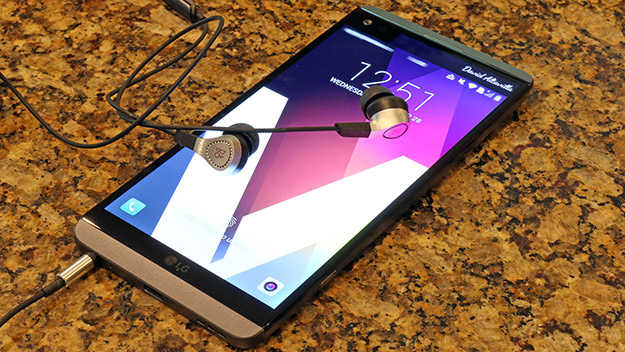LG V20 Review: Android Nougat-Infused And Feature-Rich
LG V20 Design And Build Quality
There is little question the LG V20 is a large phone. Its 5.7-inch display is big, bright and bold, but stack that LG Second Screen on top and the V20 is both tall and wide. The V20 is a well-built phone with a rather unique construction. LG notes that the V20 employs lightweight aluminum, together with a new silicon-based material called AL6013. It's a metal composite, found in aircraft, sailboats and mountain bikes and it was selected for the back plate of the phone due to its sturdy but lightweight properties. It’s comprised mostly of aluminum, but also magnesium, silicon, copper and even a bit of titanium. The top and bottom of the phone are protected from damage by Silicone Polycarbonate (Si-PC). LG claims this material, which is also found in some helmets, can reduce shocks by more than 20 percent compared to conventional materials.










The LG V10, with its stainless steel side rails, was MIL STD-810G drop compliant, and the LG V20 continues this compliance. Generally speaking, this means the V20 will survive transit drops from about 4 feet high on its face, edges and corners. Though it's large, it does cradle fairly nicely in the hand with subtly rounded corners in the back and beveled top and bottom front edges to make it a bit more pocketable.


The glass itself on the front of the display, however, is edge-to-edge with very sharp, square edges - again begging for protection against chips or dings. LG's 5.7-inch IPS Quantum display is bright and accurate with good contrast and saturation, though it can't quite compete with the AMOLED displays found in Samsung's recent Galaxy S7 series, or some of the recent Moto Z phones. Wider viewing angles are especially where you see AMOLED distance itself from IPS, but still, LG's V20 display is no slouch and even holds up well in bright daylight conditions.
LG’s second screen, similar to the V10, is back again in the V20, only now it offers double the brightness and a 50% larger font size compared to the V10’s second screen. This 160X1040 secondary IPS display allows you to receive notifications and alerts, and it also gives you quick access to a few key apps and utilities on the phone. If you were a fan of the feature before, the V20’s implementation is that much more refined and useful.
LG’s second screen, similar to the V10, is back again in the V20, only now it offers double the brightness and a 50% larger font size compared to the V10’s second screen. This 160X1040 secondary IPS display allows you to receive notifications and alerts, and it also gives you quick access to a few key apps and utilities on the phone. If you were a fan of the feature before, the V20’s implementation is that much more refined and useful.

The V20 also sports dual wide angle lenses, both a front facing selfie and a rear 8MP wide angle shooter as well, along with a standard 16MP rear camera with F1.8 aperture and OIS. The rear camera assembly, with its laser auto focus, LED flash and dual lenses, is a fairly protuberant module, but because it covers a large area of the top of the V20, it doesn't cause an uneven rock when the phone is laid on a flat surface. Still, paternal instincts prevail with us, so we'd offer it's better to find a case that will protect it.



Finally, yes, LG has all the extra features most smartphone power users want today; USB-C connectivity is here, along with a legacy 3.5mm headphone jack. There's LG's now signature removable battery feature, underneath which you'll find a dual SIM/microSD card slot for expansion. Really, when you think about it, the V20 has it all. And finally, we think LG got the back cover material just right with the V series. The V10 was rugged and anti-skid, but felt rubbery in the hand and could even hang up a bit sliding into a tight pocket area, though it was a far cry from the cheap feeling backing material found on some previous LG phones. The V20 manages to pull off a sturdy but light-weight and premium feel with its new back plate material, and though it took a day or two to grow on us, we really like it.
Let's fire up the V20 and look at the software setup...
Let's fire up the V20 and look at the software setup...







